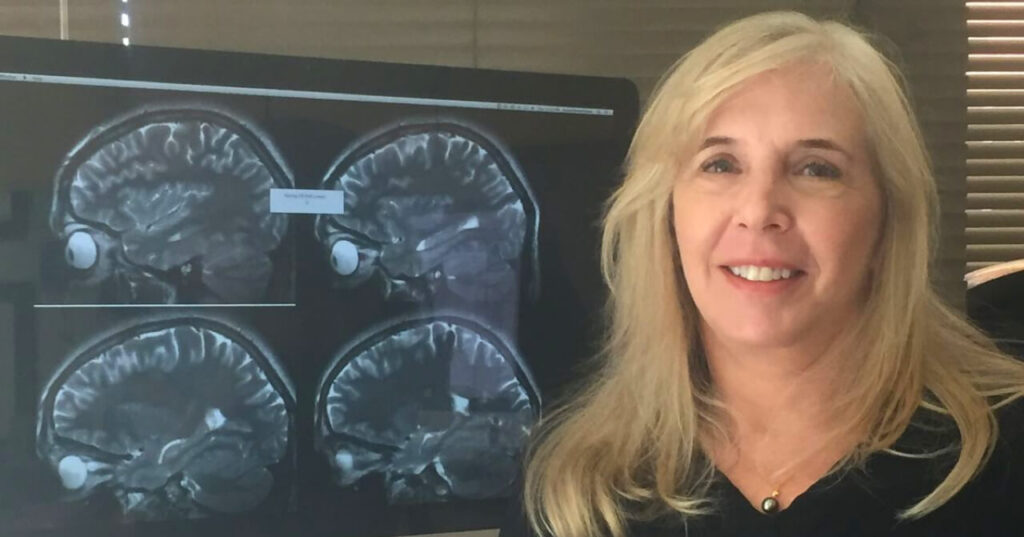Understanding the Behavior and Biology of Brain Disease

Under the leadership of Susan Bookheimer, Ph.D., the Center for Cognitive Neuroscience (CCN) has significantly enhanced our understanding of how brain functions manifest in cognition and behavior. Highlights include three vital new research findings from CCN scientists that can inform public policy and practice relating to marijuana use, stress-effects on cognitive health, and the individualization of social anxiety treatments.
Adolescent Marijuana Use Linked to Long-Term Brain Changes
Although 28 U.S. states have legalized marijuana use in some form, remarkably little study of marijuana’s long-term health effects has taken place. Enter Dr. Alison Burggren of the Staglin CCN, whose discoveries on chronic marijuana use’s effects on the brain could be very valuable to our society. Dr. Burggren has assessed older adults (age 55 and up), comparing brain structure via neuroimaging and cognition via neuropsychological testing, between a cohort whose subjects used cannabis heavily as adolescents (more than 20 times per month for over one year) and a control group whose members did not use cannabis as teens. Even though the members of the cannabis-using group had been abstinent for over 30 years, their brains showed significantly reduced (10% thinner) gray matter in the hippocampus, a brain region responsible for memory. Additionally, the cannabis-using group showed a significant reduction in several cognitive domains, including memory, reasoning, processing speed, and global cognition. Also, the cannabis-using group showed weakened integrity of the tracts of white matter that connect brain regions into circuits crucial to memory formation and consolidation.
As Dr. Bookheimer states, “These findings indicate that heavy marijuana use during adolescence may have long-lasting effects on brain structure, function, and cognition, even in subjects who have been abstinent for decades ¬ It is already known that marijuana worsens symptoms of schizophrenia among those diagnosed as well as those at-risk. With the growing trend of marijuana legalization and use of marijuana for untested medical conditions, even in children, these findings are extremely important in identifying long-term risks and hopefully will begin to inform public policy.”
Chronic Stress Increases Risky Behavior in Adolescent Boys
Research by Dr. Adriana Galván, another Staglin CCN primary faculty member, has begun to suggest ways to assist young people’s cognition when facing stressful decisions that could impact their lives. While taking on risky activity is a natural part of adolescence, three main factors can sometimes encourage risk-taking beyond healthy thresholds: psychopathology, peers, and stress. As the most understudied of these factors, and the one increasing most prominently for adolescents today, stress, and its influence on the teenage male brain and risk-taking behavior, has become a focus of Dr. Galván’s investigations. Dr. Galván has discovered that daily stress correlated with more risky decisions in adolescent males, and with weakened activity in prefrontal brain regions responsible for cognition and behavior regulation. Interestingly, this latter result contrasts with that of her study’s adult male control participants, whose frontal lobe brain activity strengthened with higher stress when making decisions.
“Overall,” Dr. Bookheimer surmises, “these data suggest that increased risk-taking behavior in adolescents may be at least partially explained by increased stress reactivity during a stressful developmental window.” This conclusion suggests that adults might help adolescents facing stressful decisions by reminding them to consider how their choices might affect future opportunities in pursuit of their goals.
Therapy for Social Anxiety Enhances Brain Connectivity and Social Calm in Tandem
Psychotherapy helps some patients with social anxiety disorder more effectively than others-and now CCN scientists have revealed part of the biological source of this variation, opening the door to better individualization of treatments. The benefit of psychotherapy for social anxiety disorder patients is thought to arise from its strengthening of the functional connection between two brain regions involved in emotion processing, the amygdala and the prefrontal cortex. When an emotional situation arises, the amygdala sends the prefrontal cortex an emotional signal, which then interprets this emotion in context and sends back a regulatory response. In emotionally charged environments, an active prefrontal cortex’s regulation via this circuit might dampen amygdala activity and maintain calm behavior.
This year, CCN scientists Michelle Craske and Katie Young assessed the strength of this connection, before and after 12 weeks of social anxiety disorder therapy, among 42 patients, as compared with a control group, which did not receive therapy until after the study. Their findings confirmed their prediction that the variation of the increase of the amygdala-cortex connection strength from patient to patient correlated with the variation in the reduction of social anxiety symptoms. These results suggest that, with further research, appropriate brain imaging assessments could benefit patients by indicating, on an individual basis, whether psychotherapy could serve as an effective treatment for social anxiety, and by highlighting precise brain circuit functions to target for the development of alternative treatments.
We at One Mind grow prouder each year of the advances the CCN has generated with the support of our donors, and congratulate Dr. Bookheimer on her Center’s accomplishments toward better public health.
